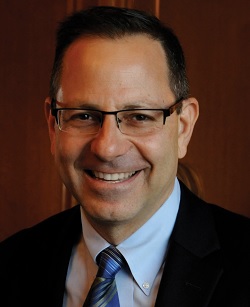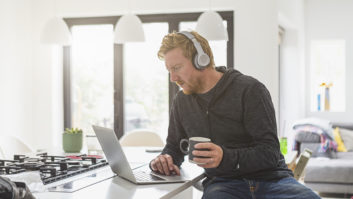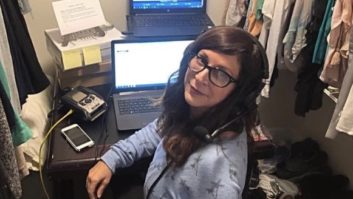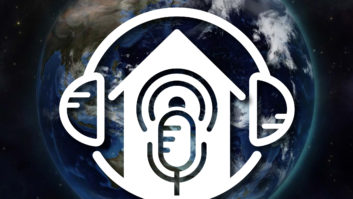
The author is executive vice president of sales, support, & marketing for the Telos Alliance.
Ever since 2003, when Telos Alliance introduced audio over IP for broadcast, the industry has been transitioning away from analog and primitive digital systems.
For over 15 years, broadcasters have been adopting AoIP infrastructure, both in radio and TV, with system after system being swapped out for truly flexible AoIP equipment. The pace of adoption has been extraordinary, but we expect that it will accelerate even more as a direct response to what broadcasters learn through their response to coronavirus.
At no other time in the history of broadcasting have entire facilities been forced to curtail their operations or even close altogether. This is our new reality as of Spring 2020. What forward-looking broadcast engineers have known for years about AoIP’s advantages, “faster, cheaper and better,” now takes a backseat to urgent requirements for facilities to remotely broadcast, including locations that have never been intended for this use (think spare bedroom or closet).
What forward-looking broadcast engineers have known for years about AoIP’s advantages… now takes a backseat to urgent requirements for facilities to remotely broadcast.
Enter virtualization on a scale we’ve never seen before. Luckily, manufacturers were already moving in this direction. Products that were previously only found in rack-mounted or tabletop hardware are available in other form factors, or as hybrids of software and servers, or even as virtual machines. Broadcasters that were skeptical are now virtualizing studios, and their trepidation at doing so is a nonissue. There is no time for “what-ifs,” and we are impressed by radio engineers who have been able to pivot nimbly to virtual operations. Just as other areas of life will be changed by the pandemic — education, healthcare, technology — so too will radio.
[Read “How to Choose Your Next Radio Console”]
The lure of a virtualized station can’t be denied. Right now, the most obvious benefit is staying on the air even when studios are shut down due to shelter-in-place edicts.
“Every engineer out there was probably waiting for this day, the big emergency, when we can’t broadcast at the studio, but we thought it would be an earthquake or fire or something,” says Paul Montoya from Wyoming Public Radio.
BEYOND CRISIS RESPONSE
But the benefits of virtualization go way beyond crisis response. Virtualized systems are easier and less expensive to update than physical equipment. Imagine having four facilities: When a piece of hardware reaches end-of-life, all four sites have to be updated on site, one by one, studio by studio.
AoIP equipment certainly makes this process much easier than the old TDM days. For one, it doesn’t have to be done all at once, but can be implemented gradually, over time. It also dramatically minimizes the amount of wiring needed and is overall faster, cheaper, and better than analog or primitive digital. Virtualization takes all this a step further because software can be updated remotely and/or all at once in a central data center, with software updates pushed out simultaneously to every facility. No physical equipment, no site visits.
Virtualization also has the potential to be more reliable than physical equipment. AoIP is already light years ahead of old analog and early digital systems in terms of reliability. In an AoIP system, there is no single point of failure, making total system failure a thing of the past. Virtualization can kick reliability up another notch by running multiple instances of software concurrently in physically diverse locations instantly available as needed. Redundancy is a highly developed concept in the IT world.
Just like AoIP dramatically reduced the amount of TDM cages and racks needed for a facility, virtualization reduces or eliminates equipment altogether, potentially making those vast equipment rooms — including abundant levels of power and cooling — a thing of the past. And with them, the cost of that associated real estate overhead.

By removing much of the physical equipment from the equation, on-site radio broadcasts via mobile radio stations also become that much easier, less expensive, with less equipment, shipping and configuration time needed to get up and broadcasting live.
Scaling broadcast operational requirements up or down and only paying for what you need is a big benefit, especially right now. Cash is king at a time when facilities need to save pennies to stay on the air as long as possible, while not paying for the entire studio to be online just for two or three systems to be on air.
From a quality perspective, we all know that audio loses something in the translation from format to format. Virtualization allows the audio packet to remain in its original format with no loss of integrity. Like in an AoIP system, the signal remains pure throughout the air chain resulting in better audio quality.
Perhaps one of the biggest benefits of a virtualized facility is the ability to interact with products from outside of broadcast, like those from the world of computing — a tablet or Windows computer, for example. By using software, you aren’t tied into proprietary hardware and have more options when it comes to designing your system. Another big plus of software is that because functionality is not hard-coded to a specific button on a console, for example, it’s highly customizable, allowing more flexibility as to functionality.
A HYBRID APPROACH
Some of our customers only recently made the move from analog to AoIP, and there are many facilities out there that still haven’t. What we’re seeing now, more than completely virtualized studio operation, is a sort of hybrid setup that uses both physical and virtual gear.
For example, your console might be more than a traditional surface — like an Axia Quasar console with traditional inputs and outputs combined with Axia IP-Tablet Virtual Radio software that puts your most used functions on a touchscreen. Andrew Zarian, CEO & Founder of Guys From Queens Network, uses an Axia Radius console and TeamViewer remote desktop tool to remotely control the surface from any web browser.
Many Axia console operators are using Axia SoftSurface to remotely produce their content during quarantine. SoftSurface was a very early cut of this kind of hybrid back when no one ran their consoles on a touchscreen or computer. It allowed broadcasters to run on a virtual surface yet still have the full functionality of a console. As I write this, SoftSurface is controlling consoles all over the world as broadcasters are forced to leave studios and work from remote locations.
Our IP-Tablet product includes a virtual mixing software module for our xNode that allows users to access the internal mixer inside; change sources and routes; and control the levels of each with virtual faders. When you combine this software with an xNode you get a fully customizable mini mixer. Just like a smartphone, you can add other IP-Tablet Virtual Radio “apps” to create even more virtual radio studio functionality, including those that control other products like the Omnia.9, Telos VX, and more. This software-based approach dramatically enhances the functionality and value of your console. Customized facilities are more available to all broadcasters–not just the ones in larger markets.
It’s remarkable the level of ingenuity that broadcast engineers are tapping into in order to help studios stay on the air right now. We look forward to when all of this is over, when broadcasters have a choice again as to how and where they produce content, and indeed, more choice of virtualized offerings as manufacturers create and refine products to catch up to the current need during pandemic.
The importance of this moment in broadcast history will not be lost on manufacturers. In the meantime, thank you to all the radio engineers out there for keeping us all together through the power of radio, even when we can’t be!












